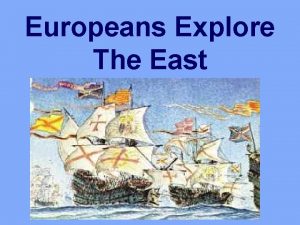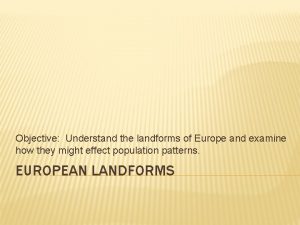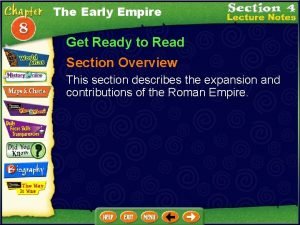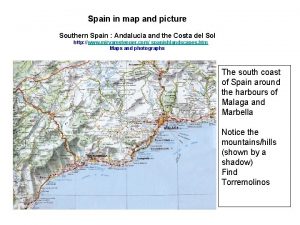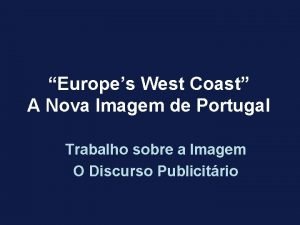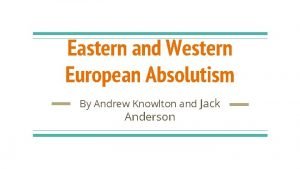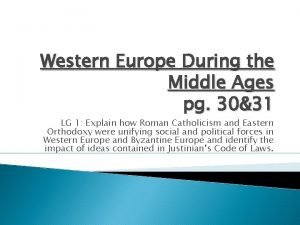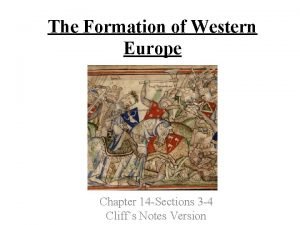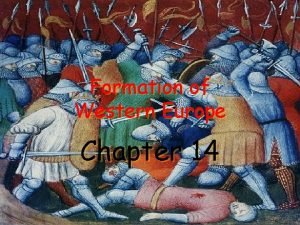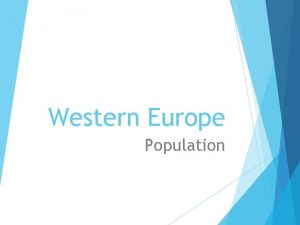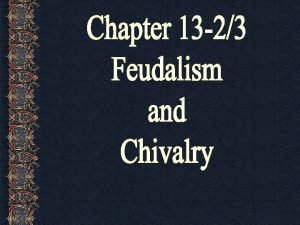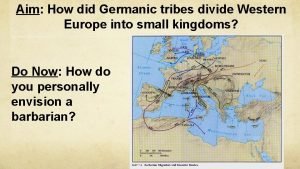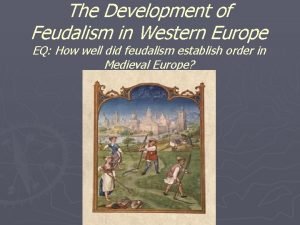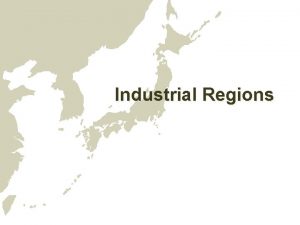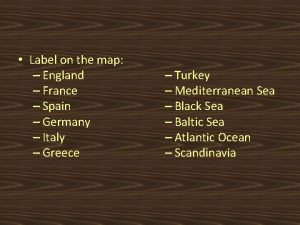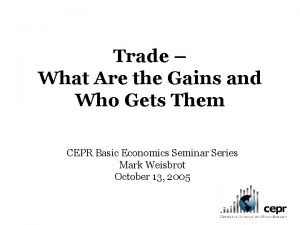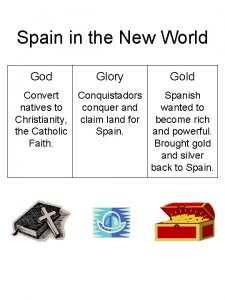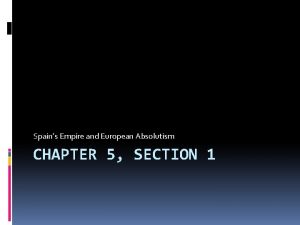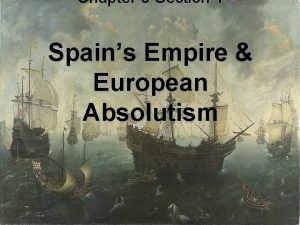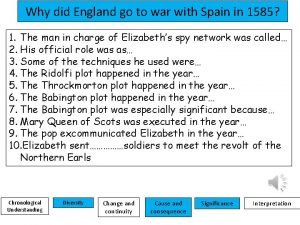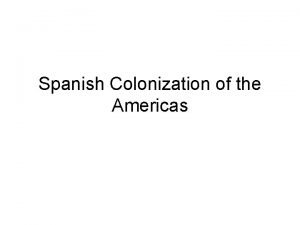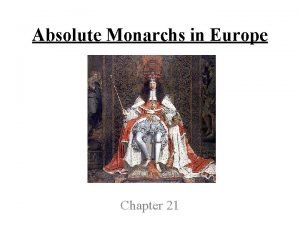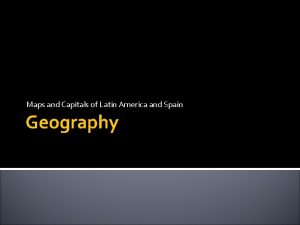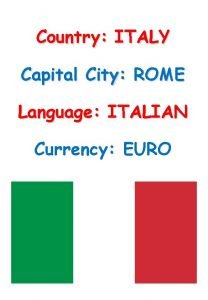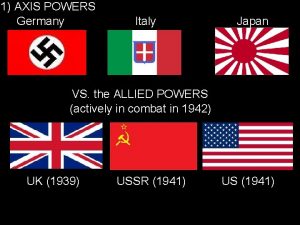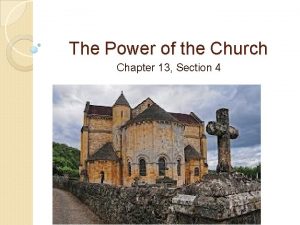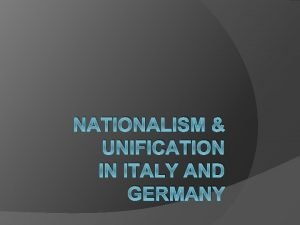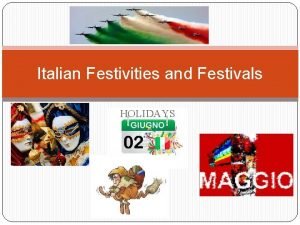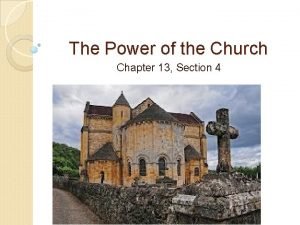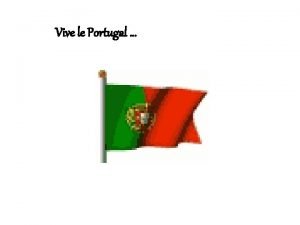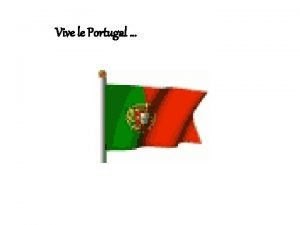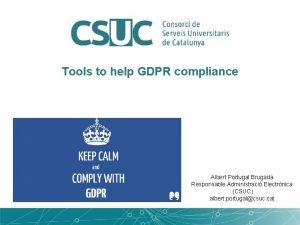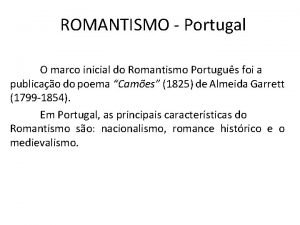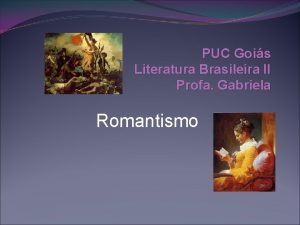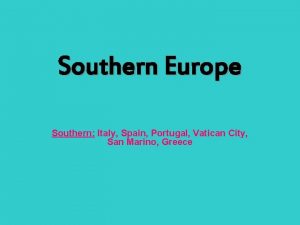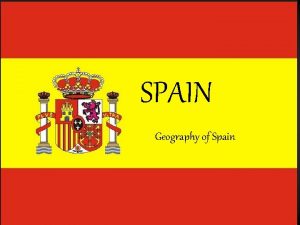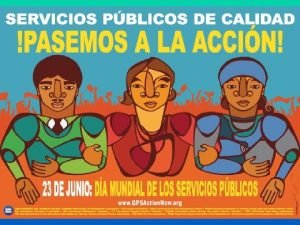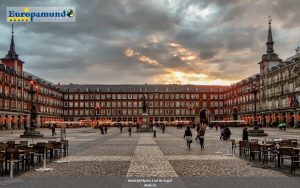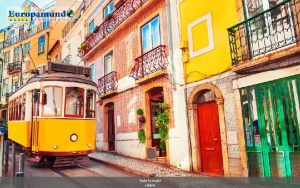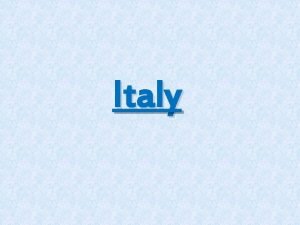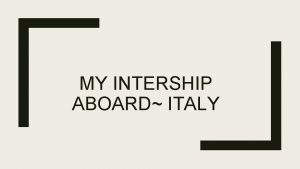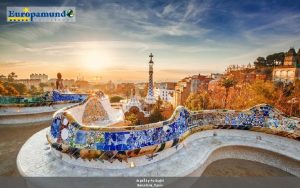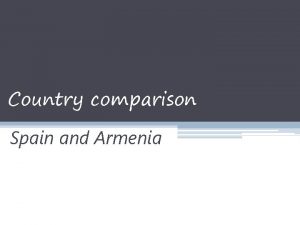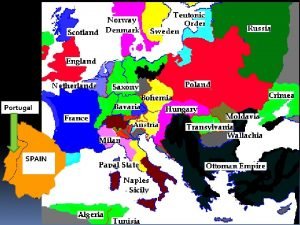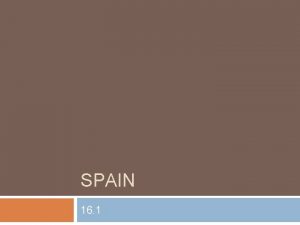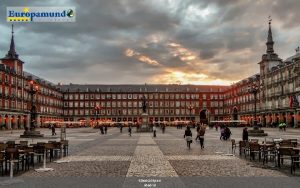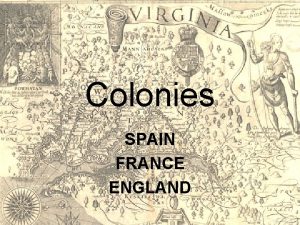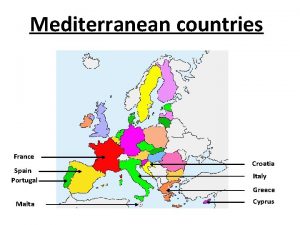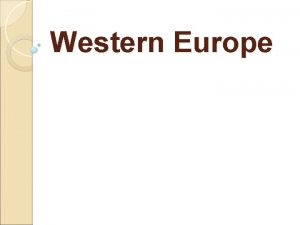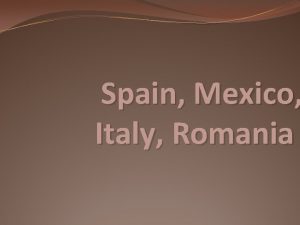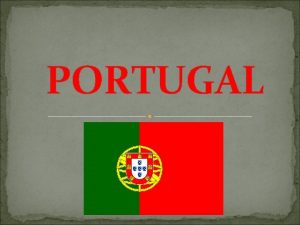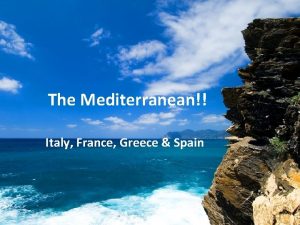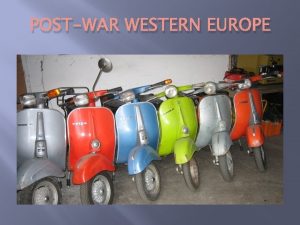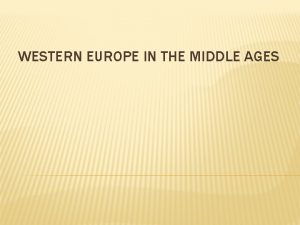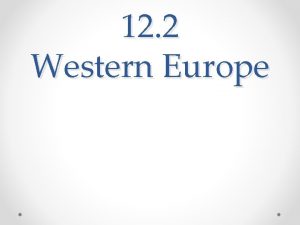Southern and Western Europe Southern Italy Spain Portugal










































- Slides: 42

Southern and Western Europe Southern: Italy, Spain, Portugal, Vatican City, San Marino, Greece Western: France, Germany, Belgium, The Netherlands, Luxembourg, Switzerland, Austria, Liechtenstein

Italy San Marino Spain Portugal Vatican City Greece

Netherlands Belgium Liechtenstein Germany France Switzerland Austria Luxembourg

Physical Features • Peninsulas – Iberian (home to Spain and Portugal) • Pyrenees Mountains – block off peninsula from rest of Europe – Italian (boot of Italy) • Alps – Most famous mountain chain in Europe – Stretch across France, Italy, Germany, Switzerland, Austria, and the northern Balkan Peninsula – Cut Italy off from rest of Europe • Islands – Corsica, Sardinia, Sicily, Crete

Rivers of Europe • There are NUMEROUS rivers throughout Europe • Rhine River – Most important river in Western & Southern Europe – 820 miles

Climates • Western Europe: – Marine West Coast (mainly) – Highland Humid Subtropical • Southern Europe: – Mainly Mediterranean – Some Marine West Coast, Semiarid, and Humid Subtropical

Southern and Western Resources • Majority Zinc and Coal • Biggest variety of resources found in Spain • Resources throughout the rest of Western and Southern Europe is scattered

Water Pollution: Venice • Industrial waste, sewage, and saltwater combine together and eat away the foundations of buildings (damage) • Erosion is allowing large amounts of seawater into the lagoon – “Killer Algae”: decaying algae uses up all the oxygen which causes fish in water to die as well = insects in water = STENCH!

ITALY n Rich culture n The Roman Empire n n n Ruled most of the Italian Peninsula Grew by conquering overseas territories The Renaissance (‘rebirth’) – a renewed interest in learning (Leonardo Da. Vinci)

Landmarks n Rome is the capital & largest city n Home to the Colosseum and other Roman ruins.

n Southern Italy has many natural disasters Earthquakes, Volcanic Activity, Floods, & Droughts n Home to Mt. Vesuvius and the ancient city of Pompeii

Italy’s Economic Problems n Italy: n n Northern region is much more developed than Southern region Why? 1. 2. 3. North is closer to industrial nations (Germany & France) South = poor transportation systems Southern government made poor decisions when promoting growth

• The island of Sicily – large island on the southern coast of Italy • Mt. Etna, an active volcano

SPAIN & PORTUGAL l l l Together form the Iberian Peninsula Capital of Spain = Madrid Capital of Portugal = Lisbon

l One of the world’s largest tourist industries • Beaches & rich culture

l l Fishing is a large part of economy Have a long history of sailing

l Leading producer of cork – corkboards, shoes, wine stoppers

Background n The Iberian Peninsula was ruled by the Moors (a Muslim people from North Africa) for over 700 years

n Were the most powerful European nations; controlled sea trade during the 15 th – 16 th century – Had a huge colonial empire and was a leader in the spice trade.

VATICAN CITY • An independent state surrounded by the city of Rome • Smallest country in the world (0. 2 sq. Miles)

• The pope, the head of the Roman Catholic church, has absolute political authority within the city

GREECE • Agricultural products – olive oil, tobacco, grapes, & citrus fruits • Shipping is big part of economy

Background • Ancient Greece – vital to the development of Western culture (roots of democracy)

• Ancient city of Olympia – site of the first Olympic Games

• Ancient city of Sparta – famous for its athletes and warriors (movie “ 300”)

• Capital = Athens • Home of the Acropolis with the Parthenon (one of the world’s most photographed and famous buildings)

SAN MARINO Ø San Marino was founded early in the 4 th century by Christians escaping persecution Ø One of the oldest and smallest republics / countries

Western Europe



Rise of Nation-States Feudalism Ø l l : political and economic system Powerful LORDS owned most of the land Strong kings gain power over feudal lords Ø Evolved into l : Fierce loyalty to. Nationalism one’s nation Ø Contributed to yearnings for independent countries

Modern Conflicts Ø WWI: Axis Powers: Germany Austria-Hungary **Their allies Ø Causes: l Rivalries and competition for colonies • Central Powers vs. Allied Powers l l l Assassination of Archduke Franz Ferdinand Allied Powers: OUTCOMES: France Britain Consequences for Germany. Great Russia • Take blame, pay reparations, couldn’t Italy form an US army

Modern Conflicts Axis Powers: Ø WWII: Japan Ø Causes: Italy l German resentment from WWI Germany l Rise of Adolf Hitler to power l Axis Powers vs. Allied Powers: Ø Outcomes: l l l Holocaust Division of Germany Berlin Wall U. S. Great Britain Soviet Union **BIG THREE**

Holocaust Facts and Images Ø Religious Genocide (Mass Murder of Jews) Ø Around 6 million fell victim to concentration camps Ø Also targeted were gypsies, vagrants, and homosexuals

Berlin Wall Ø Divided between East and West l West controlled by: • Britain, US, and France • More democratic l East controlled by: • • • Soviet Union Communist influenced “Satellite” nations

Economic Diversity and Luxury Ø Strong economy (agriculture, manufacturing, & high-tech service industry) Ø Agricultural Resources: dairy farming, livestock raising (export), wheat, grapes, vegetables Ø Industry: coal and iron ore Ø Electronics: Netherlands, France, and Germany Ø Switzerland: Banking

Tourism Ø Climate, scenery, and historic sites encourage many to travel to Western Europe l Major part of the economy (France, Switzerland, and Austria) Ø Luxuries: Cars, Jewelry, high fashion clothing

Germany’s Economic Problems Ø What caused economic problems? l Reunification of Germany Ø Western European nations (and West Germany) were much more advanced l l United Germany couldn’t keep up or catch the eastern parts up Outdated factories Ø Progress is occurring, but will take time to see results

Music and Art Ø Germany: l l Johann Sebastian Bach Ludwig von Beethoven Ø Austria: l Wolfgang Amadeus Mozart Ø Arts: l l l Jan Van Eyck (painter; used oils) Rembrandt (Dutch painters—Realism) Claude Monet (French—impressionist)


Modern Life Ø Prosperous economies = high standard of living (mucho dinero) l Many Western Europeans live in cities Ø City life: l l Transportation, attractions (arts, plays, museums, etc. ) Low crime rates Small houses = more public socialization Paid vacation (more than what Ams. receive)

Modern Conflicts Ø Immigration: Ø “Guest Workers” from Serbia & Montenegro/Turkey (to West Germany) l Economic problems blamed on these workers (stole jobs, etc. ) Ø Austria and remarks from leader defending Nazis; caused racial tensions l Fear of rebirth of racist politics
 1200
1200 Spain and portugal
Spain and portugal Major landforms in hungary
Major landforms in hungary Read ready
Read ready Southern spain map
Southern spain map Portugal europe's west coast
Portugal europe's west coast Differences between eastern and western absolutism
Differences between eastern and western absolutism Western uplands europe
Western uplands europe Western europe after the fall of rome
Western europe after the fall of rome Chapter 14 the formation of western europe
Chapter 14 the formation of western europe Chapter 14 the formation of western europe
Chapter 14 the formation of western europe Population of western europe
Population of western europe Invaders attack western europe
Invaders attack western europe Feudalism
Feudalism The development of feudalism in western europe
The development of feudalism in western europe Western europe hdi
Western europe hdi Eastern europe landforms
Eastern europe landforms Map of england and france and spain
Map of england and france and spain England and portugal
England and portugal For spain for glory for gold
For spain for glory for gold Chapter 5 section 1 spain's empire and european absolutism
Chapter 5 section 1 spain's empire and european absolutism Chapter 5 section 1 spain's empire and european absolutism
Chapter 5 section 1 spain's empire and european absolutism Why did england and spain go to war
Why did england and spain go to war God gold glory spanish philippines
God gold glory spanish philippines Bolivia christmas food
Bolivia christmas food Chapter 21 absolute monarchs in europe
Chapter 21 absolute monarchs in europe My grandpa eats honey nut cheerios periodically
My grandpa eats honey nut cheerios periodically Will italian
Will italian Axis powers – germany, italy, japan
Axis powers – germany, italy, japan Otto invades italy on pope's behalf causes and outcomes
Otto invades italy on pope's behalf causes and outcomes Nationalism in italy and germany
Nationalism in italy and germany Cultural holidays in italy
Cultural holidays in italy Causes of otto invades italy on pope's behalf
Causes of otto invades italy on pope's behalf Nationalism case study italy and germany
Nationalism case study italy and germany Vive le portugal
Vive le portugal Vive le portugal
Vive le portugal Fenazopiridina portugal
Fenazopiridina portugal Slbet portugal
Slbet portugal Pedro luziense de bittencourt calasans (1837-1874)
Pedro luziense de bittencourt calasans (1837-1874) Foz do rio lima
Foz do rio lima Contexto histórico do romantismo
Contexto histórico do romantismo Language
Language Christmas eve in portugal
Christmas eve in portugal

